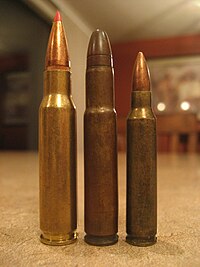This article has multiple issues. Please help improve it or discuss these issues on the talk page . (Learn how and when to remove these messages)
|
| .32 Remington | ||||||||
|---|---|---|---|---|---|---|---|---|
 .308 Winchester (left) .32 Remington (middle) .223 Remington (right) | ||||||||
| Type | Rifle | |||||||
| Place of origin | United States | |||||||
| Production history | ||||||||
| Designer | Remington Arms | |||||||
| Specifications | ||||||||
| Case type | rimless | |||||||
| Bullet diameter | 0.321 in (8.2 mm) | |||||||
| Neck diameter | 0.341 in (8.7 mm) | |||||||
| Shoulder diameter | 0.394 in (10.0 mm) | |||||||
| Base diameter | 0.418 in (10.6 mm) | |||||||
| Rim diameter | 0.418 in (10.6 mm) | |||||||
| Case length | 2.06 in (52 mm) | |||||||
| Overall length | 2.54 in (65 mm) | |||||||
| Rifling twist | 1 turn in 14" | |||||||
| Maximum pressure | 36,000 psi (250 MPa) | |||||||
| Maximum CUP | 37,000 [1] CUP | |||||||
| Ballistic performance | ||||||||
| ||||||||
| Test barrel length: 22 Source(s): Whelen, Townsend. The American Rifle. The Century Co: 1918, p. 263. | ||||||||
The .32 Remington (also known as the .32 Remington Auto-Loading or .32 Remington Rimless) is an American rifle cartridge. A rimless, smokeless powder design, this cartridge was once considered to be suitable for game larger than deer and black bear. [2] Similar contemporary cartridges include the rimmed .32 Winchester Special, a cartridge introduced by Winchester and offered as a chambering in Winchester's lever-action rifles.